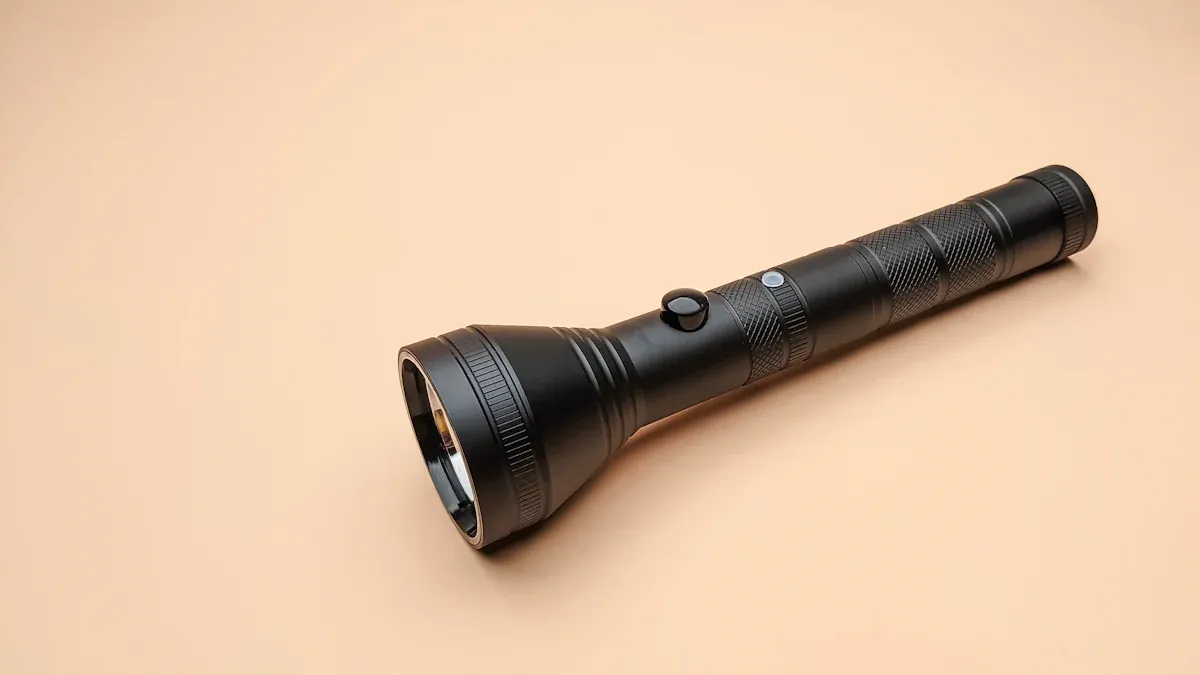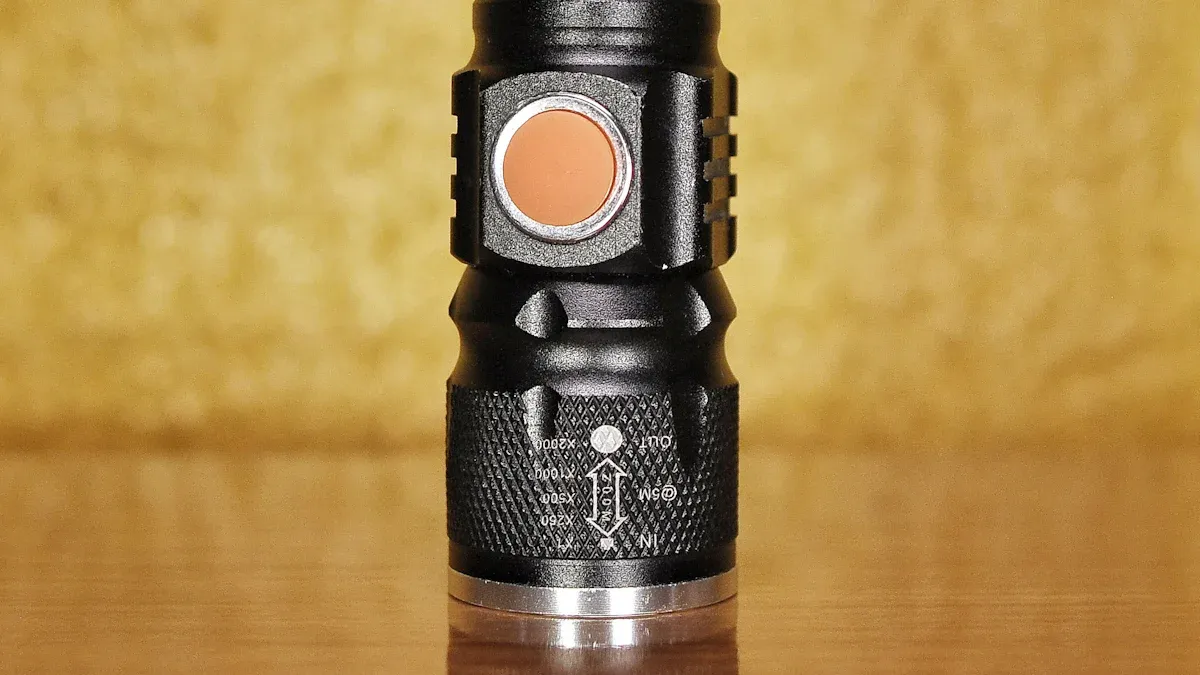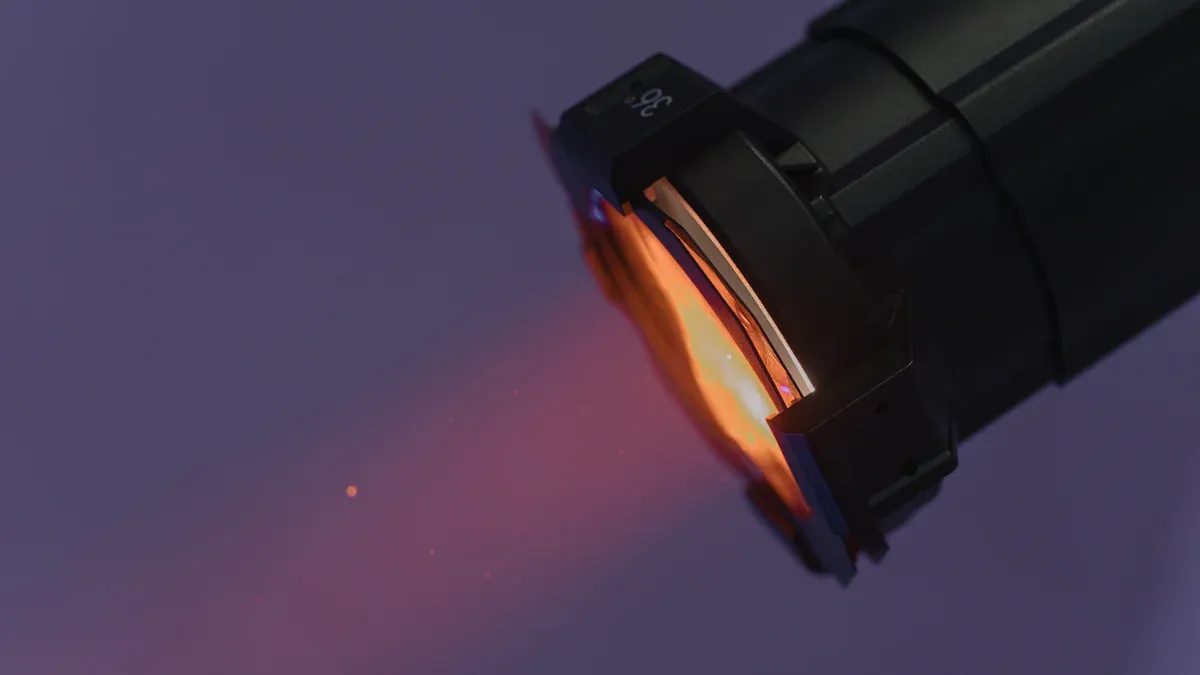The Role of Flashlights in Providing Safety During Nighttime Emergencies

Nighttime emergencies can strike unexpectedly, leaving you vulnerable in the dark. A flashlight becomes your lifeline in situations like prolonged power outages, car breakdowns, or even earthquakes. Its ability to illuminate your surroundings ensures safety and helps you navigate hazards. The importance of flashlights in emergencies cannot be overstated—they are essential tools for survival.
Key Takeaways
Flashlights are important for staying safe during emergencies at night. They help you see clearly, avoid dangers, and prevent getting hurt.
You can use a flashlight to ask for help. Flashlights with blinking or SOS settings can grab attention and help rescuers find you.
Pick a strong, good-quality flashlight that lasts a long time. LED flashlights are great because they are bright and save energy.
Why Flashlights Are Crucial for Nighttime Emergencies

Enhancing Visibility in Low-Light Conditions
A flashlight is your most reliable tool when navigating dark or low-light conditions. Whether you’re dealing with a power outage or a natural disaster, its beam cuts through the darkness, allowing you to see obstacles and move safely. Unlike candles or smartphone screens, a flashlight provides focused and consistent light, ensuring you can assess your surroundings effectively. This makes it an essential item in any emergency survival kit.
Signaling for Help in Emergencies
In emergencies, signaling for rescue can mean the difference between life and death. A flashlight in an emergency situation serves as a powerful signaling device. For instance:
Hikers lost in the Appalachian Mountains used a flashlight to guide a rescue helicopter to their location.
A homeowner blinded an intruder with a flashlight, buying time to call the police.
A motorist stranded on a deserted road used a flashlight’s strobe feature to attract help from a passing driver.
These examples highlight how a flashlight can save lives by drawing attention to your location or deterring threats. Its versatility makes it indispensable during emergencies.
Avoiding Hazards and Navigating Safely
Nighttime emergencies often involve hidden dangers, such as debris from a natural disaster or uneven terrain. A flashlight helps you identify and avoid these hazards, reducing the risk of injury. Its portability allows you to carry it wherever needed, ensuring you can navigate safely even in the most challenging conditions. Including a flashlight in your emergency survival kit ensures you’re prepared to handle unexpected obstacles.
Key Features of an Effective Flashlight in an Emergency
Brightness and Beam Distance
The brightness of a flashlight plays a critical role in emergencies. It determines how well you can see and navigate your surroundings. The table below outlines recommended brightness levels for various use cases:
Lumen Range | Use Case Description |
|---|---|
1-100 Lumens | Low brightness for close-up tasks like reading a map or finding items in a tent. |
100-300 Lumens | Ideal for general use, such as walking at night or navigating dimly lit areas. |
300-500 Lumens | Good balance for camping or searching in larger areas. |
500-1000 Lumens | Suitable for caving or search and rescue missions with longer beam distance. |
Designed for professional use or extreme outdoor adventures, illuminating large areas. |
Beam distance is equally important. A flashlight with a longer beam distance improves visibility in low-light conditions, which is essential for search and rescue operations. It allows you to illuminate distant objects, detect hazards, and locate individuals in remote areas.
Battery Life and Power Options
A flashlight in an emergency must have a long battery life to ensure continuous operation. Lithium-ion batteries are highly reliable due to their long shelf life and ability to perform well in extreme temperatures. The table below highlights some common battery types:
Battery Type | Characteristics |
|---|---|
Li-ion (18650, etc.) | Holds charge well, suitable for emergency use, avoids leakage with parasitic draw. |
Energizer Ultimate | Performs well in extreme temperatures, low leakage risk, ideal for car storage. |
Primary Lithium | Long shelf life, decent output, minimal leakage risk. |
LSD NiMH (Eneloop) | Good for long-term use, but may degrade over time without optimal care. |
Choosing the right battery type ensures your flashlight remains operational when you need it most.
Durability and Weather Resistance
Emergencies often occur in harsh conditions. A high-quality flashlight should withstand impacts, rain, and extreme temperatures. Look for models with durable materials and weather-resistant features. For example, Fenix flashlights are built to endure tough environments, making them a reliable choice for emergencies.
Portability and Ease of Use
A portable flashlight is easier to carry and use during emergencies. Compact designs with ergonomic grips allow you to handle the flashlight comfortably. LED flashlights are particularly lightweight and efficient, making them ideal for lighting your environment in critical situations. Additionally, features like one-button operation and adjustable brightness enhance usability, ensuring you can focus on the task at hand.
How to Use a Flashlight Effectively During Emergencies
Conserving Battery Power
During emergencies, conserving your flashlight’s battery power is critical to ensure it lasts as long as possible. You can follow several best practices to achieve this:
Use the flashlight only when necessary. Turn it off when you don’t need light.
Switch to a lower brightness setting if your flashlight has adjustable modes. This reduces power consumption.
If you have fewer batteries available, use aluminum foil as a substitute for a second battery. Roll a strip of foil into a tube that fits alongside the actual battery. While this method provides dimmer light, it can be sufficient for emergency situations.
By adopting these strategies, you can extend the operational time of your flashlight in an emergency, ensuring it remains functional when you need it most.
Using Flashlights for Signaling
A flashlight is not just a source of light; it is also a valuable tool for signaling rescue crews. To attract attention, use the strobe or SOS mode if your flashlight has one. These modes are designed to create noticeable patterns that can be seen from a distance. If your flashlight lacks these features, manually flash the light in intervals to mimic an SOS signal. This technique can help rescuers locate you quickly, especially in remote areas or during nighttime emergencies.
Positioning the Flashlight for Maximum Illumination
Proper positioning of your flashlight ensures you get the most effective illumination. Hold the flashlight at chest level to cast light evenly across your path. If you need hands-free operation, use a headlamp or secure the flashlight to a stable surface. For tactical flashlights, adjust the beam focus to suit your needs—wide beams work well for close-up tasks, while narrow beams are ideal for spotting distant objects. These adjustments can help you navigate safely and avoid hazards during emergencies.
Pairing Flashlights with Other Emergency Tools
Combining your flashlight with other emergency tools enhances your preparedness. For example, use a flashlight alongside a whistle to signal for help more effectively. Pair it with a multi-tool to handle tasks like cutting or repairing items in low-light conditions. A flashlight in an emergency also works well with reflective gear, amplifying visibility for rescue teams. By integrating your flashlight with other tools, you can tackle emergencies more efficiently and increase your chances of staying safe.
Choosing the Right Flashlight for Nighttime Emergencies

Assessing Your Specific Needs
Selecting the right flashlight begins with understanding your specific requirements. Consider the following factors:
Intended use: Determine if the flashlight is for outdoor activities, home emergencies, or part of an emergency preparedness kit.
Environment and lighting conditions: Assess whether you’ll use it in complete darkness, low-light areas, or well-lit environments.
Personal preferences: Think about your comfort with brightness levels and flashlight size.
By evaluating these aspects, you can narrow down your options and choose a flashlight that aligns with your needs.
Comparing Flashlight Types (LED, Tactical, etc.)
Different flashlight types offer unique advantages and disadvantages. The table below highlights some common options:
Flashlight Type | Advantages | Disadvantages |
|---|---|---|
LED | Energy-efficient, long-lasting | May cost more upfront |
Tactical | Durable, multiple brightness settings | Typically more expensive |
Hand-Cranked | No reliance on batteries | Requires manual effort to charge |
USB Rechargeable | Easy to recharge, versatile | Exposed ports may reduce waterproofing |
EDC (Everyday Carry) | Compact, versatile for daily use | Limited brightness |
For emergencies, the best LED flashlights often strike a balance between brightness, durability, and energy efficiency. Tactical flashlights are also excellent for their rugged design and advanced features.
Evaluating Build Quality and Features
A flashlight’s build quality determines its reliability during emergencies. Focus on these key features:
Battery Life and Rechargeability: Opt for flashlights with long runtimes and rechargeable options for extended use.
Durability and Water Resistance: Look for impact-resistant materials and high water resistance ratings like IPX7 or IPX8.
Ergonomics and Ease of Use: Choose a flashlight with a comfortable grip, lightweight design, and intuitive controls.
Additional Features: Consider options like adjustable brightness, strobe modes, and specialized beam patterns for added versatility.
These features ensure your flashlight performs well under challenging conditions.
Budget Considerations and Value for Money
Balancing cost and quality is crucial when choosing a flashlight in an emergency. Avoid common mistakes like selecting models with inadequate runtime or poor durability. Instead, prioritize value by focusing on essential criteria:
Runtime: Choose a flashlight that can last several days or even weeks.
Durability: Ensure it can withstand harsh conditions with features like water and shock resistance.
Brightness: Look for sufficient lumens to meet your needs.
Versatility: Features like multiple output modes and clips enhance usability.
Investing in a reliable flashlight may cost more initially, but it ensures long-term performance and safety during emergencies.
Flashlights play a critical role in ensuring safety during nighttime emergencies. Their life-saving power lies in their ability to illuminate hazards, signal for help, and provide reliable light. Investing in a survival flashlight offers long-term benefits, including enhanced brightness, powerful battery life, and durability. Keeping one accessible can make all the difference in emergencies.
A high-quality flashlight is not just a tool—it’s a vital part of your emergency preparedness plan.
FAQ
What type of flashlight is best for an emergency kit?
Choose a durable, compact flashlight with long battery life. LED models are ideal for their energy efficiency and brightness, making them perfect for survival situations.
How many flashlights should you include in your emergency kit?
Include at least two flashlights in your emergency kit. This ensures you have a backup in case one fails, increasing your survival preparedness.
Can a flashlight replace other light sources in an emergency kit?
A flashlight is essential but cannot replace all light sources. Complement it with candles or lanterns for extended survival situations requiring broader illumination.
See Also
Why Rechargeable Flashlights Are Crucial for Community Safety
Choosing Between Lanterns and Flashlights for Camping Trips
Why Every Hunter Needs a Reliable Flashlight for Outdoors
A Homeowner's Guide to Selecting the Right Emergency Flashlight
Comparing Police Flashlights and Regular Ones: What’s Superior?
